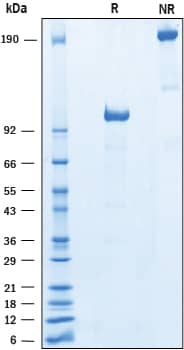Recombinant Mouse DLL4 Fc Chimera Protein, CF
R&D Systems, part of Bio-Techne | Catalog # 10089-D4

Key Product Details
Source
NS0
Accession #
Structure / Form
Disulfide-linked homodimer
Conjugate
Unconjugated
Applications
Bioactivity
Product Specifications
Source
Mouse myeloma cell line, NS0-derived mouse DLL4 protein
| Mouse DLL4 (Gly27-Pro525) Accession # Q9JI71 |
IEGRMDP | Human IgG1 (Pro100-Lys330) |
| N-terminus | C-terminus |
Purity
>90%, by SDS-PAGE visualized with Silver Staining and quantitative densitometry by Coomassie® Blue Staining.
Endotoxin Level
<0.10 EU per 1 μg of the protein by the LAL method.
N-terminal Sequence Analysis
Gly27
Predicted Molecular Mass
81 kDa
SDS-PAGE
97-108 kDa, reducing conditions
Activity
Measured by the ability of the immobilized protein to enhance BMP-2 induced alkaline phosphatase activity in C3H10T1/2 mouse embryonic fibroblast cells. Nobta, M. et al. (2005) J. Biol. Chem. 280:15842.
The ED50 for this effect is 0.02-0.2 μg/mL.
The ED50 for this effect is 0.02-0.2 μg/mL.
Scientific Data Images for Recombinant Mouse DLL4 Fc Chimera Protein, CF
Recombinant Mouse DLL4 Fc Chimera Protein Bioactivity
Immobilized Recombinant Mouse DLL4 Fc Chimera enhances Recombinant Human BMP-2 (Catalog # 355-BM) induced alkaline phosphatase activity in C3H10T1/2 mouse embryonic fibroblast cells. The ED50 for this effect is 0.02-0.2 µg/mL.Recombinant Mouse DLL4 Fc Chimera Protein SDS-PAGE
2 μg/lane of Recombinant Mouse DLL4 Fc Chimera was resolved with SDS-PAGE under reducing (R) and non-reducing (NR) conditions and visualized by Coomassie® Blue staining, showing bands at 97-108 kDa and 190-210 kDa, respectively.Formulation, Preparation and Storage
10089-D4
| Formulation | Lyophilized from a 0.2 μm filtered solution in PBS. |
| Reconstitution | Reconstitute at 500 μg/mL in PBS. |
| Shipping | The product is shipped at ambient temperature. Upon receipt, store it immediately at the temperature recommended below. |
| Stability & Storage | Use a manual defrost freezer and avoid repeated freeze-thaw cycles.
|
Background: DLL4
References
- Shutter, J.R. et al. (2000) Genes Dev. 14:1313.
- Iso, Tatsuya et al. (2002) Arterioscler. Thromb. Vasc. Biol. 23:543.
- Walker, L. et al. (2001) Stem Cells 19:543.
- Baron, M. (2002) Semin. Cell Dev. Biol. 14:113.
- Ikeuchi, T. and S.S. Sisodia (2003) J. Biol. Chem. 278:7751.
- Bland, C.E. et al. (2003) J. Biol. Chem. 278:13607.
Long Name
Delta-like 4
Alternate Names
delta 4, Delta 4 precursor, delta ligand 4, Delta4, delta-like 4 (Drosophila), delta-like 4 homolog, delta-like 4 homolog (Drosophila), delta-like 4 protein, delta-like protein 4, Drosophila Delta homolog 4, hdelta2, MGC126344, notch ligand delta-2, notch ligand DLL4
Gene Symbol
DLL4
UniProt
Additional DLL4 Products
Product Documents for Recombinant Mouse DLL4 Fc Chimera Protein, CF
Product Specific Notices for Recombinant Mouse DLL4 Fc Chimera Protein, CF
For research use only
